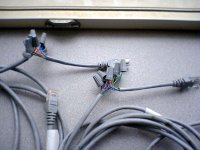The passive electronics inside a ControlNet tap aren't just for filtering, they're to reduce the connector-related reflections you get anytime you go through a bulkhead or tap with a RF-frequency signal.
The idea behind a ControlNet tap is to, well, "tap off" just a small amount of the signal on the trunk line and deliver it with maximum amplitude and clarity to the end of a 1-meter cable.
Part 2 of the ControlNet Specification includes a table of characteristic specifications that a ControlNet tap must meet for inductance, capacitance, resistance, and transmission and reflection characteristics.
If you were to cut one open, you'd find a 56 pF capacitor, a .56 uH inductor, and a little 18-turn autotransformer wound around a toroidal core all connected in parallel.
In my experience, you will NOT get good results using BNC tees in place of ControlNet taps. It might work for a small network or for a little while, but you're setting yourself up for a frustrating and fruitless experiment in pennywisdom. Removal of non-spec taps is part of every ControlNet troubleshooter's checklist.




